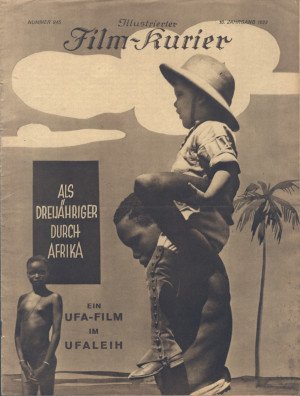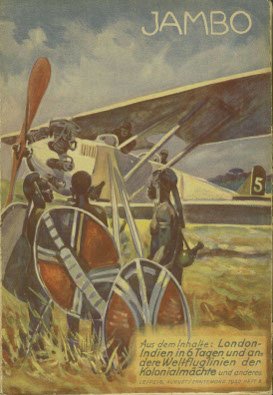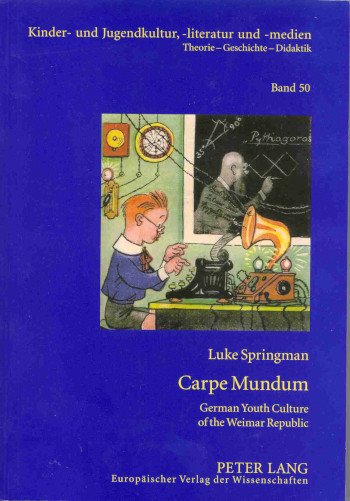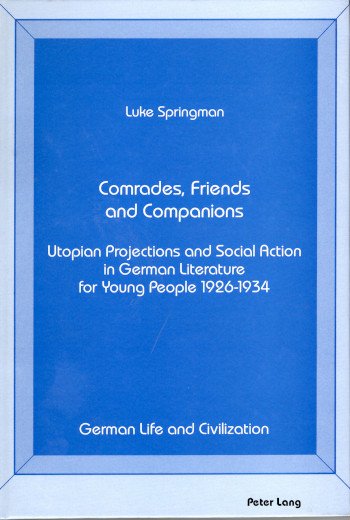Research
Working on a book about colonialism and youth culture in Weimar Germany (1918-1933)
- Africa in Weimar film
- Africa in fiction, non-fiction, and periodicals for young people.
- Teaching about the former German colonies in schools (Geography and History)
- Colonialist propaganda and youth


Imag(in)ed Hegenomies: Colonialist Literature for German Youth during the Weimar Republic
A "flood" of popular literature about Africa swept the book market in Germany after it had irretrievably forfeited all its colonial possessions at the end of World War I. From 1884 to 1914, Germany had become the world's third or fourth largest colonial power (depending whether one referred to land mass or to population); in Africa, Germany had claimed territory in what is today Togo, Cameroon, Tanzania, and Namibia. Overseas possessions, however, affected the German economy and culture little in comparison with the impact colonies had on England and France. Nevertheless, a dedicated minority of influential Germans devoted serious and sustained efforts after 1918 to keep alive the desire for empire in Germany. Their influence precipitated a surge of colonialist literature in the mid-1920s that maintained a strong presence in popular culture well after the end of the Weimar Republic (1918-1933), despite the indifference the general public held toward reclaiming colonies. Theoretical considerations include rhetorical interplays between images and written texts and inventions of cultural memory in print, film, and education. An analysis of the campaigns to generate a collective colonialist mindset reveals both the power and the impotence of imperialist propaganda during the Weimar period in Germany.
Published Books
Carpe Mundum analyzes German Youth culture during the Weimar Republic (1918-1933). Each chapter addresses a distinct topic: sex educational materials for young people, the language of the censorship debates, novels dealing with war, historical narration, magazines, popular science and science fiction, radio, and sports. Together the themes illustrate the influence of nineteenth-century holistic thinking in popular culture in early twentieth-century Germany. Public policies and institutions governing German youth culture during the Weimar Republic, including education and social welfare, evince spiritual underpinnings of Naturphilosophie – a movement which promoted the unity of all things. As cultural modernity in Germany enabled young people greater participation in shaping their culture, elements of a modernity of youth emerged as distinct from that of the adult world and its ideologically laden system of values. The essence of youthful modernity in Germany as evident most clearly in popular magazines, radio, and sports rests primarily on spontaneity, ingenuity and camaraderie.

Comrades, Friends and Companions: Utopian Projections and Social Action in German Literature for Young People 1926-1934 (German Life and Civilization 3), 1989.
Comrades, Friends and Companions provides the first critical analysis of classic German novels for young people of the late Weimar Republic. The author reveals how purportedly realistic portrayals of youth in groups projected a "better world" in the years of social and political crisis. These alternative realities in the German adolescent novel of the time evince the pedagogical and ideological struggles that were endemic in Weimar Culture. This study also confronts the early work of Erich Kästner and his restructuring of authority in the Enlightenment pattern of the "model child".

Published Essays
- “Kinder- und Jugendliteraturhistoriographie. Das zwanzigste Jahrhundert. Jahrbuch für Internationale Germanistik. 6, 2 (2025): 309-328.
- “’Bleibt noch ein Lied zu singen’: Autobiographical and Cultural Memory in Christa Wolf's Novel Kindheitsmuster.” In: “einmal alles von Anfang an erzählen”: The Social, Political, and Personal Dimensions of Storytelling. Eds. Kristy Boney and Jennifer Marston Williams (Rochester: Camden House, 2018), 221-233.
- “Propaganda and Nostalgia: Constructing Memories about the German Democratic Republic for Young People.” In: Reinventing Childhood Nostalgia. Ed. Elisabeth Wesseling (Abingdon-on-Thames: Routledge, 2017), 122-134.
- "Africa in Ritual Practice and Mythic Consciousness in the Kulturfilm of the German Weimar Republic (1918-1933)." In: The Child Savage, 1890-2010 - From Comics to Games. Ed. Elisabeth Wesseling (Surrey: Ashgate, 2016), 86-102.
- "Die Kinder- und Jugendliteratur der Weimarer Republik als Spiegel der gesellschaftlichen und politischen Situation in Deutschland." In: Die Kinder- und Jugendliteratur in der Zeit der Weimarer Republik. Ed. Norbert Hopster. Kinder- und Jugendkultur, -literatur und -medien 74. Vol. 2 (Frankfurt am Main: Peter Lang, 2012), 975-993.
- "Technik-Literatur für Kinder und Jugendliche." In: Die Kinder- und Jugendliteratur in der Zeit der Weimarer Republik. Ed. Norbert Hopster. Kinder- und Jugendkultur, -literatur und -medien 74. Vol. 1 (Frankfurt am Main: Peter Lang, 2012), 423-451.
- "Koloniale Kinder- und Jugendliteratur." In: Die Kinder- und Jugendliteratur in der Zeit der Weimarer Republik. Ed. Norbert Hopster. Kinder- und Jugendkultur, -literatur und -medien 74. Vol. 1 (Frankfurt am Main: Peter Lang, 2012), 229-267.
- "Exotic Attractions and Imperialist Fantasies in Weimar Youth Culture." In: Weimar Culture Revisited. Ed. John Williams (New York: Palgrave-MacMillan, 2011), 99-116.
- “Technikbegeisterung und nationale Machtphantasien: Science-Fiction und Sachliteratur in der Jugendliteratur der Weimarer Republik (Teil 2).” Kinder- und Jugendliteraturforschung 2007/2008 (2008): 37-47.
- “Technikbegeisterung und nationale Machtphantasien: Science-Fiction und Sachliteratur in der Jugendliteratur der Weimarer Republik (Teil 1).” Kinder- und Jugendliteraturforschung 2006/2007 (2007): 41-49.
- “The Disney Trap oder Erich Kästner im amerikanischen Kino.” In: Erich Kästners weltweite Wirkung als Kinderschriftsteller. Eds. Bernd Dolle-Weinkauf, Hans H. Ewers, Ute Dettmar. Frankfurt am Main: Peter Lang (2002): 68-76
- “Children's Literature.” Encyclopedia of German Literature. Vol. 1. Ed. Matthias Konzett. Chicago: Fitzroy Dearborn Publishers (2000): 188-193.
- “Monster Metaphors. The Reconstruction of German Youth in the Weimar Republic.” Carver (1998): 57-65.
- “Poisoned Hearts, Diseased Minds, and American Pimps: The Language of Censorship in the Schund und Schmutz Debates.” The German Quarterly 4, 68 (1995): 408-429.
- “Historical Consciousness and Jewish Identity: Stefan Zweig and Wilhelm Speyer on the Way to Themselves.” Insiders and Outsiders. Jewish and Gentile Culture in Germany and Austria. Ed. Dagmar C. G. Lorenz and Gabrielle Weinberger. (Detroit: Wayne State UP, 1994): 155-174.
- “A ‘Better Reality:' The Enlightenment Legacy in Erich Kästner's Novels for Young People.” The German Quarterly 4, 64 (1991): 518-530.